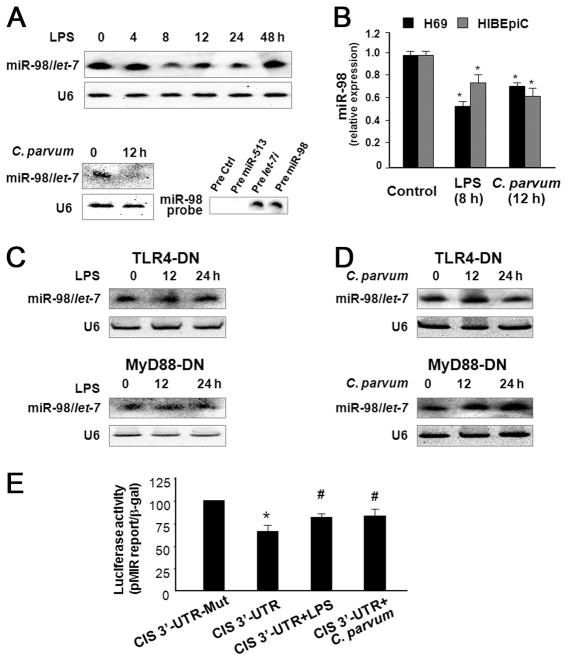FIGURE 4.
LPS stimulation and C. parvum infection decrease expression of miR-98 and let-7 in a TLR4/MyD88-dependent manner resulting in relief of translational suppression of CIS in cholangiocytes. A, LPS stimulation and C. parvum infection decrease miR-98/let-7 expression in H69 cells by Northern blot analysis. RNU6B (U6) was used as a loading control. The miR-98 probe used for Northern blotting recognizes both precursors for miR-98 and let-7, but not a nonspecific precursor or the precursor for miR-513, confirming its specificity. B, LPS stimulation and C. parvum infection decrease miR-98 expression in both H69 and HIBEpiC cells as assessed by real-time PCR. *, p < 0.05 ANOVA vs the controls. C and D, LPS- and C. parvum-induced down-regulation of miR-98/let-7 expression is TLR4/MyD88-dependent. H69 cells stably transfected with TLR4-DN or MyD88-DN were exposed to LPS (C) or C. parvum (D) followed by Northern blotting. RNU6B (U6) was used as a loading control. E, Relief of miRNA-mediated translational suppression of CIS 3′-UTR in H69 cells following LPS stimulation or C. parvum infection. Cells were transfected with the pMIR-REPORT luciferase construct containing the CIS 3′-UTR with both the putative binding sites. Luciferase activity in cells after exposure to LPS or C. parvum was then measured and normalized to β-gal. Data represent three independent experiments. *, p < 0.05 ANOVA vs CIS 3′-UTR mutant control; #, p < 0.05 ANOVA vs CIS 3′-UTR transfected cells.

